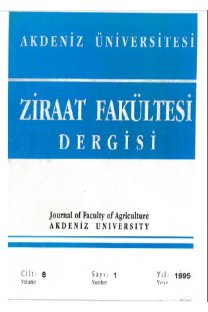Heterosis for certain yield and quality traits in winter triticale
hibritler, hibrit çeşitler, ürün verimi, bitki ıslahı, melez azmanlığı, tritikale
Tritikale'de bazı verim ve kalite özelliklerinde heterosis
hybrids, hybrid varieties, crop yield, plant breeding, heterosis, triticale,
___
- A.A.C.C. 1969. American Association of Cereal Chemists. Cereal Laboratory Methods (7. Press), Inc. St. Paul. Minnesota.
- Muntzing, A., 1989. Triticale Today.Tricale:A Promissing Addition To The World’s Cereal Grains. 1-7. National Research Council, National Academy Press, U.S.A.
- Oettler, G., Becker,H.C. and Hoppe, G., 2001. Heterosis for Yield and Other Agronomic Traits of Winter Triticale F1 And F2 Hybrids, Plant Breeding, 20: 351-353.
- Oettler, G., Burger H. and Melchinger, A.E., 2003. Heterosis and Combining Ability for Grain Yield and Agronomic Traits in Winter Triticale. Plant Breeding , 122 : 318-321.
- Pfeiffer, W.H., Sayre, K.D. and Mergoum, M., 1998. Heterosis in Spring Triticale Hybrids. Proceedings of the 4th Int. Triticale Symp., Red Deer Vol. I: 86-91.
- Poehlman, J.M., 1979. Breeding Field Crops, AVI Publishing Co. Inc. Westport, Connecticut. U.S.A.
- Tritical, 2002. http//www.resourceseeds.com/ TRITICAL. triticale/ triticale
- Weiβmann, S. and Weiβmann, A.E., 2002. Hybrid Triticale-Prospects for Research and Breeding- Part 1: Why hybrids? Proceedings of the 5h Int. Triticale Symp., Vol I,188-191, June 30-July 5. Radzikow,Poland.
- Yagdı, K. and Coplu, N., 2004. A Research on the Hybrid Vigor in Triticale, Selcuk University, The Journal of Agricultural Faculty 33/18: 33-38.
- ISSN: 1301-2215
- Yayın Aralığı: 2
- Başlangıç: 1983
- Yayıncı: Akdeniz Üniv. Ziraat Fak.
Heterosis for certain yield and quality traits in winter triticale
Aydoğan Esra CIFCI, Koksal YADGI
The evaluation of horticultural extension in Hanover Region of Germany
Factors affecting meat and meat products consumtion quantities in Sanlıurfa province
Elektromanyetik alanın cardinal üzüm çeşidi kalemlerinin vejetatif gelişimi üzerindeki etkileri
Farklı toprak işleme aletlerinin ve ilerleme hızının toprak yüzey düzgünlüğü üzerine etkisi
Investigation of some seed quality components in winter rapeseed grown in Çanakkale province
Kemal Muhammet GÜL, Ömer Cem EGESEL, FATİH KAHRIMAN, Şemun TAYYAR
Katı atık depolama alanlarının bitkisel ıslahına bir örnek: Adana-Sofulu çöp depolama alanı
